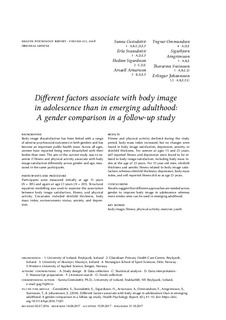| dc.contributor.author | Gestsdottir, Sunna | |
| dc.contributor.author | Svansdottir, Erla | |
| dc.contributor.author | Sigurdsson, Hedinn | |
| dc.contributor.author | Arnarsson, Arsaell | |
| dc.contributor.author | Ommundsen, Yngvar | |
| dc.contributor.author | Arngrimsson, Sigurbjorn | |
| dc.contributor.author | Sveinsson, Thorarinn | |
| dc.contributor.author | Johannsson, Erlingur | |
| dc.coverage.spatial | Iceland | nb_NO |
| dc.date.accessioned | 2019-03-28T09:39:34Z | |
| dc.date.available | 2019-03-28T09:39:34Z | |
| dc.date.created | 2017-11-21T12:49:25Z | |
| dc.date.issued | 2017 | |
| dc.identifier.citation | Gestsdottir, S., Svansdottir, E., Sigurdsson, H., Arnarsson, A., Ommundsen, Y., Arngrimsson, S., … Johannsson, E. (2018). Different factors associate with body image in adolescence than in emerging adulthood: A gender comparison in a follow-up study. Health Psychology Report, 6(1), 81-93. | nb_NO |
| dc.identifier.issn | 2353-4184 | |
| dc.identifier.uri | http://hdl.handle.net/11250/2592120 | |
| dc.description.abstract | Background: Body image dissatisfaction has been linked with a range of adverse psychosocial outcomes in both genders and has become an important public health issue. Across all ages, women have reported being more dissatisfied with their bodies than men. The aim of the current study was to examine if fitness and physical activity associate with body image satisfaction differently across gender and age, measured in the same participants. Participants and procedure: Participants were measured initially at age 15 years (N = 385) and again at age 23 years (N = 201). Structural equation modelling was used to examine the association between body image satisfaction, fitness, and physical activity. Covariates included skinfold thickness, body mass index, socioeconomic status, anxiety, and depression. Results: Fitness and physical activity declined during the study period, body mass index increased, but no changes were found in body image satisfaction, depression, anxiety, or skinfold thickness. For women at ages 15 and 23 years, self-reported fitness and depression were found to be related to body image satisfaction, including body mass index at the age of 23 years. For 15-year-old men, skinfold thickness and aerobic fitness related to body image satisfaction, whereas skinfold thickness, depression, body mass index, and self-reported fitness did so at age 23 years. Conclusions: Results suggest that different approaches are needed across gender to improve body image in adolescence whereas more similar ones can be used in emerging adulthood. | nb_NO |
| dc.language.iso | eng | nb_NO |
| dc.publisher | Termedia | nb_NO |
| dc.rights | Navngivelse-Ikkekommersiell-DelPåSammeVilkår 4.0 Internasjonal | * |
| dc.rights.uri | http://creativecommons.org/licenses/by-nc-sa/4.0/deed.no | * |
| dc.title | Different factors associate with body image in adolescence than in emerging adulthood: A gender comparison in a follow-up study | nb_NO |
| dc.type | Journal article | nb_NO |
| dc.type | Peer reviewed | nb_NO |
| dc.description.version | publishedVersion | nb_NO |
| dc.rights.holder | © 2017 Institute of Psychology, University of Gdansk | nb_NO |
| dc.subject.nsi | VDP::Samfunnsvitenskap: 200::Psykologi: 260::Utviklingspsykologi: 265 | nb_NO |
| dc.source.pagenumber | 13 | nb_NO |
| dc.source.volume | 6 | nb_NO |
| dc.source.journal | Health Psychology Report | nb_NO |
| dc.source.issue | 1 | nb_NO |
| dc.identifier.doi | 10.5114/hpr.2018.71201 | |
| dc.identifier.cristin | 1516626 | |
| cristin.unitcode | 203,1,32,0 | |
| cristin.unitname | Senter for utdanningsforskning - Bergen | |
| cristin.ispublished | true | |
| cristin.fulltext | original | |
| cristin.qualitycode | 1 | |

